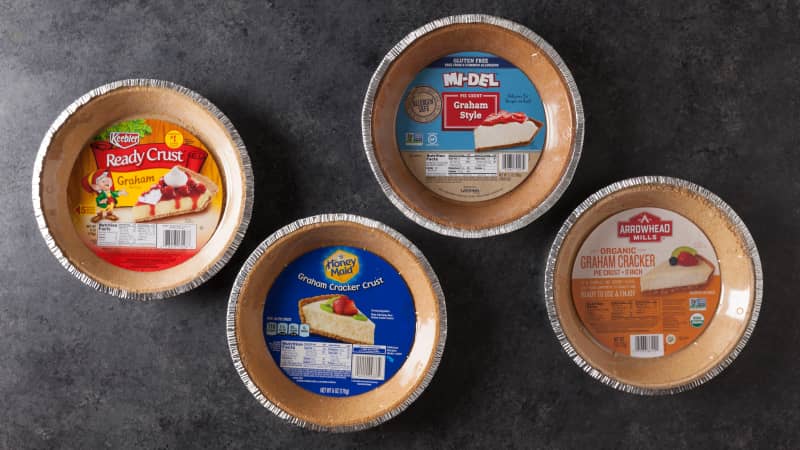The Best Pie Plates
Equipment Review
When a homemade crumb crust isn’t an option, is a store-bought crust an acceptable stand-in?
Published Oct. 1, 2017.

Making a homemade graham cracker crust isn’t hard: Just whirl graham crackers, sugar, and melted butter in a food processor and pat into a pie plate—no rolling pin or crimping skills required. But if you’re short on time, store-bought graham cracker crusts can save you from lugging out the food processor. And since they’re sold already patted into disposable aluminum pie plates and prebaked, you can skip the blind-baking step usually required to set a homemade graham cracker crust before filling it.
To determine which was the best store-bought option, we bought four top-selling nationally available graham crusts priced from $2.49 to $3.99, including one gluten-free crust, and asked 21 staff members to taste them plain and in our Lemon Icebox Pie.
“Graham” is just another term for coarsely ground whole-wheat flour; it refers to Sylvester Graham, a prominent 19th-century preacher who encouraged eating a bland, whole-grain diet as a way to stave off temptation and lust. Sugary, nutty graham cracker crusts made primarily from enriched wheat flour (a misleading term for plain white flour) scarcely resemble the bland bricks Graham envisioned, but they still usually contain at least traces of whole-wheat flour. It’s no surprise, then, that tasters immediately singled out one crust: the gluten-free product, which was made with rice flour, tapioca starch, and “natural graham flavor” instead of wheat flour. It was, in short, unpalatable: crumbly, chalky, and mushy, with a lingering array of fruity and vegetal aftertastes. We vastly preferred products that stuck to a mixture of white and whole-wheat flours, which produced the subtle, slightly nutty flavor and tender texture we were looking for.
But that’s not to say products made from wheat flour were completely free from texture problems. One wheat-flour crust was gritty and shattered into hundreds of tiny pieces when we sliced into it. A comparison of the ingredient labels revealed that it contained less fat than our top-ranked products—4 grams per 21-gram serving, compared with 5 grams in our favorite crusts. Flour needs fat to create structure and shape; products with more fat were tender and moist and could be cut into pristine, neat slices. Though none of the products contain butter (like our homemade graham cracker crust does), we found that those with enough vegetable oil could replicate the moist, even crumb we like in graham crusts.
Flavor was important, too. A good crust is a supporting actor—it should add some pizzazz but not steal the show—so any crusts with overpowering sweetness or distracting strong flavors were out. Sweetness in the crusts came from a variety of source...
The mission of America’s Test Kitchen Reviews is to find the best equipment and ingredients for the home cook through rigorous, hands-on testing.

This is a members' feature.